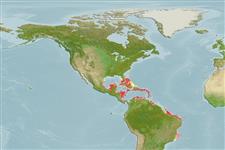Common names from other countries
Classification / Names / Names
Common names | Synonyms | Catalog of Fishes (gen., sp.) | ITIS | CoL | WoRMS
Environment: milieu / climate zone / depth range / distribution range
Ecology
Benthic; depth range 0 - 18 m (Ref. 2022). Tropical
Western Central Atlantic: Colombia and the Caribbean Sea.
Length at first maturity / Size / Weight / Age
Maturity: Lm ? range ? - ? cm
Epibiotic, rocky intertidal (Ref. 110502). Crevices in coral rocks (Ref. 2022)..
Life cycle and mating behavior
Maturity | Reproduction | Spawning | Eggs | Fecundity | Larvae
Members of the class Polyplacophora are mostly gonochoric. Life cycle: Eggs hatch into lecitotrophic planktonic trocophore larvae (no veliger stage) which later metamorphose and settle on the bottom as young adults.
Gracia, A.C., J.M. Diaz and N.E. Ardilla. 2005. (Ref. 2022)
IUCN Red List Status (Ref. 130435)
CITES status (Ref. 108899)
Not Evaluated
Not Evaluated
Threat to humans
Harmless
Human uses
| FishSource |
Tools
More information
Age/Size
Growth
Length-weight
Length-length
Morphology
Larvae
Abundance
Internet sources
Estimates based on models
Preferred temperature
(Ref.
115969): 27 - 28.4, mean 27.7 (based on 159 cells).
Price category
Unknown.
